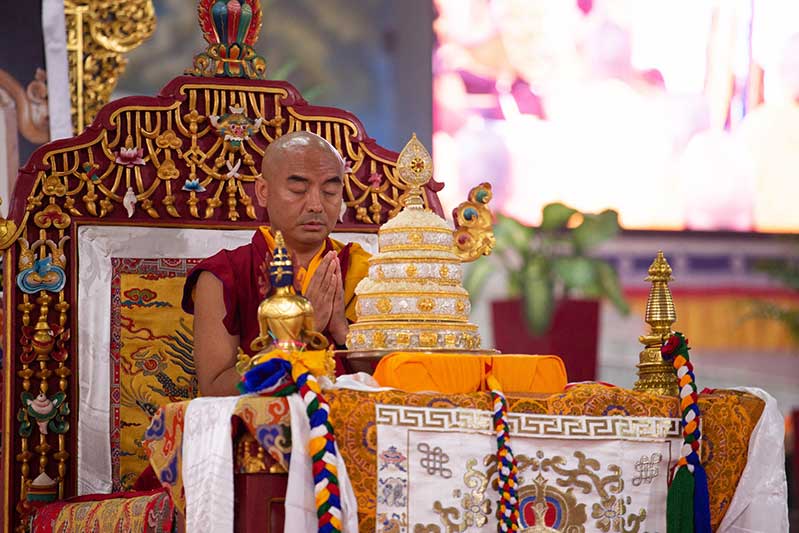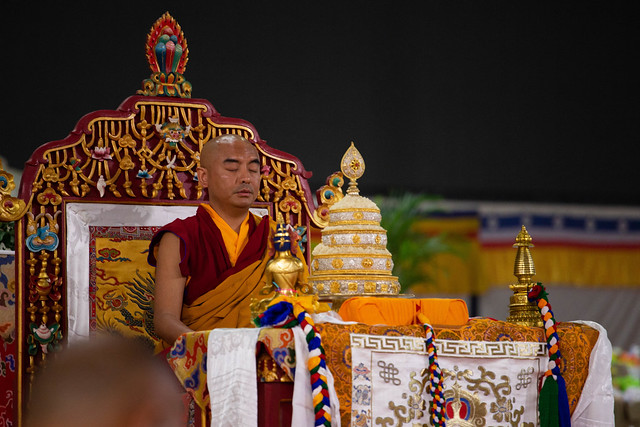
The Pavilion, Bodh Gaya, India
January 30, 2020
In this ninth and final teaching session on the Four Foundations of Mindfulness, Yongey Mingyur Rinpoche fleshed out the framework he had been developing over the three-day teaching, giving the assembly a glimpse backward with a pithy summary of the key earlier points and a glimpse forward into new terrain. Having covered the meditation methods of the Foundation Vehicle and the Mahayana or Greater Vehicle, he briefly delved into the Secret Mantra Vajrayana practices that enable tantric Buddhists to swiftly traverse the paths and levels of realization. He reminded us of the extremely special and profound instructions of the Karma Kagyu, the lineage of practice, even though— as he had commented earlier — it was not appropriate to convey advanced meditation instructions to the assembly at this time. This brief glimpse of advanced Vajrayana practice served to underscore Rinpoche’s earlier emphasis on the importance of a strong foundation, especially by making use of the Foundation Vehicle teachings on the Four Foundations of Mindfulness. Having devoted much of the teaching to the foundation, Rinpoche now briefly suggested what kind of magnificent edifice one might build on such a strong base.
Rinpoche reminded everyone to give rise to bodhicitta, remembering all sentient beings as we listened to the dharma, before summarizing the shamatha and insight instructions previously covered. He noted that there are three levels of insight meditation: Foundation Vehicle (Theravadin) teachings, Mahayana, and Vajrayana insight practices. The insight of the Foundation Vehicle, as previously explained, is mainly concerned with impermanence, suffering, emptiness and selflessness. The Mahayana insight emphasizes selflessness of persons (egolessness) and selflessness of phenomena; the union of appearance and emptiness is the particular purview of Mahayana insight meditation. Then, in the Secret Mantra Vajrayana, we have creation phase and completion phase practices, as well as the special form of insight known as Mahamudra.
Rinpoche gave a brief, lucid summary of the main goal and emphasis of creation-stage practice, in which one visualizes oneself as a particular deity with a particular realm and qualities: “Out of the inherent emptiness of phenomena, we arise in the luminous nature of the deity. It is like a reflection in a mirror, like a rainbow in the sky, like a dream.” Visualizing the deity in this way, as luminous and empty, is the “emptiness of the object.” When we rest with our awareness during the practice, that is shamatha. When we experience these two together, this is the union of shamatha and insight. Rinpoche explained that the creation stage always begins with arousing the two forms of bodhicitta — loving-kindness and compassion (relative) and emptiness (ultimate). Then, from a seed syllable, the deity arises with those innate qualities inherent in its appearance. Also innate to the deity are the qualities of purity, ripening, and completion. For this reason, deity practice is an extremely swift and profound path. The practitioner-as-deity embodies all the qualities of buddha-hood, purifies all realms, ripens all sentient beings, and perfects all aspirations. So, Rinpoche summarized, “Within the creation phase, there is loving-kindness, compassion, and bodhicitta; there’s shamatha and insight in union; and there are the resultant qualities, the bodies of the buddha.” The practice cuts through dualistic concepts and swiftly brings results. This is Vajrayana insight in the creation stage.
In the completion stage, where the practitioner dissolves the visualization and rests in emptiness, we work with the channels and winds, binding impure elements within the “vajra body.” Gradually, as we progress through the levels with this practice, thoughts stop at this stage and we are able to rest; this allows for the emergence of the wisdom of bliss and emptiness. Rinpoche intimated that initially, there is an effort here, but that eventually it is a natural process: “This is the path of analogy. From that, actual wisdom arises.”
Rinpoche next gave a brief overview of mahamudra, the profound practice of nature of mind meditation specific to the Karma Kagyu school of Tibetan Buddhism. He explained that within mahamudra, there is Sutra mahamudra, Tantra mahamudra, and Essence mahamudra. Generally, the most well-known is Sutra mahamudra, taking the meaning taught in the King of Samadhi sutra and the points on buddha nature taught in the Sublime Continuum by Maitreya. For the actual practice, we follow the path Lord Gampopa laid out for us, uniting the Kadampa lineage of mind training (lojong) with mahamudra practices brought to Tibet from India by Marpa the Translator. Our usual progression in Sutra mahamudra involves the Four Ordinary and Four Extraordinary practices (Ngondro), followed by pointing-out instructions from our lama. These include recognizing mind when it is still or in motion, recognizing appearances, and recognizing the mind during thoughts. We can realize coemergent wisdom through these methods.
Rinpoche commented here that there is nothing different or unique about the nature of the object — the mind — in these practices. It is still the mind of luminous emptiness, selflessness, impermanence, and the other forms of insight discussed in previous parts of the teaching. But in working with the subject — the practitioner or perceiver — Vajrayana methods are uniquely swift and potent.
As for Tantra mahamudra, this is associated with the Six Yogas of Naropa, and Rinpoche didn’t elaborate on it further. Essence mahamudra is based on the guru’s pith instructions, which he said “reveal the unadulterated, coemergent wisdom that is already currently with us.” The guru points out the nature of our mind, and if we are ready, we recognize it. To be ready, Rinpoche commented, one needs a strong foundation in the earlier practices, especially Tantra mahamudra; one must go in stages, beginning with the preliminaries. Of Essence mahamudra, Rinpoche commented, “I could explain it here, but we don’t have a lot of time. But I could put a seed, and if you continued to practice, at some point you would definitely pacify the afflictions. These pith instructions have particular blessings and a particular lineage in our Dakpo Kagyu. We have a protector lineage of meditation and practice. So if you practice with real effort, you will definitely develop experience and realization in stages. Please keep this in mind.”
Having completed this exquisite overview of Vajrayana insight practices, Rinpoche devoted most of the rest of this final session to short, guided meditations intended to help us leverage and apply the various methods he had introduced in prior sessions. In particular, he asked us, “With all these practices, how do we change afflictions and suffering?” He began by walking us through the practices emphasized in the morning, resting and analytical meditation. Rinpoche suggested taking any thought, emotion, or mind poison as an object of meditation. He had us simply look at the object: “If you find it, examine it. If not, rest. Then you analyze again. You just go back and forth until they become unified. Grasping, afflictions and ego-clinging will decrease. Eventually, your experience will become realization.” The emphasis on guided practice in this final session instilled confidence and also refreshed our understanding of the morning’s presentation of analytical meditation — inquiring into the nature of the mind and its creations. Always a gentle and encouraging teacher, Rinpoche recommended that we avoid objects of meditation that overwhelm or scare us — perhaps strong anger or emptiness of self. He once again reminded us that as long as we are aware, we don’t have to arrive at any specific outcome as we meditate, find any specific thing, or change, discard, or create anything in our experience.
Rinpoche also sketched in a way to measure our progress. He described three progressive levels of insight — understanding, experience, and realization — using the traditional Kagyu analogy of the moon: understanding is like seeing pictures of the moon in a book; experience is like seeing the reflection of the moon in still water on a clear night; and realization is like looking up and seeing the moon in a clear sky. Rinpoche commented that the first stage of realization is like seeing a sliver of crescent moon, and that full buddhahood would entail seeing the full moon. Rinpoche commented, “If we only use the sutra methods, emptiness of the object, it takes three innumerable aeons using that kind of insight. But the focus on the emptiness of the subject is quick.”
Perhaps tying up loose ends or addressing material he felt he’d not quite fleshed out, Rinpoche briefly returned to the Mahayana levels of insight. He commented that there is debate about whether realizing the egolessness of self means one also realizes the egolessness of phenomena, and to give us a taste of the latter, he walked us through an analytical meditation of the composite appearance of his face. This was fun, and it was also a skillful refresher on the all-important methods of analytical meditation.
Finally, returning to the theme of settling the afflictive emotions, Rinpoche ran us through a quick scan of our new tools. We can use shamatha to look directly at a negative emotion. We can use the Foundation-Vehicle insight of looking at the changing sensations of the affliction. We can see its many parts, its emptiness, impermanence, and interdependence. Applying Mahayana insight, we can ask, “Who’s experiencing this anger?” We can see it as a dream experience. Rinpoche commented, “You can alternate these so as not to get bored. You can cycle through them; they enhance each other.”
He ended with a request: “So please continue to practice. You’ll develop peace in your mind, loving-kindness and compassion, and the realization of emptiness.” He then asked us to dedicate to all sentient beings the merit generated by listening to the dharma for these three wonderful and precious days. During the ensuing tea break, a fortunate group of disciples presented elaborate offerings to Rinpoche, and the assembly chanted, as with one great voice, aspiration prayers for the realization of mahamudra and the welfare of Tibet.


































